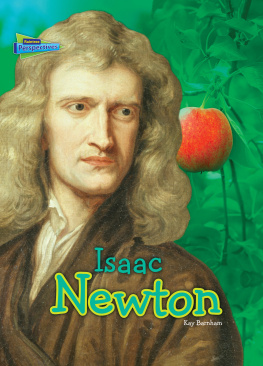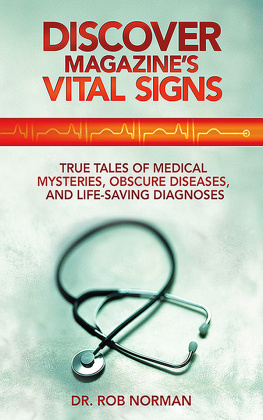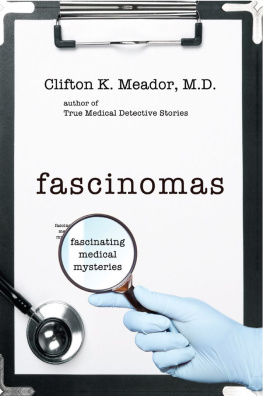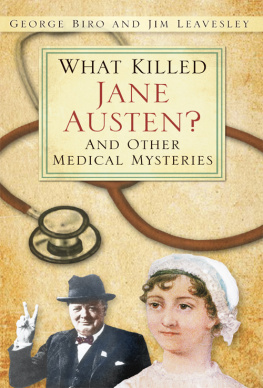This book is dedicated
by Jim Leavesley to his grandchildren:
Gabrielle, Amelia, Jack and Emma.
And by George Biro to his children:
Andrew and Jackie.
After the success of their previous book, What Killed Jane Austen?, it was obvious to the authors that there is a wide interest in the trivia of medical history. To satisfy this natural curiosity about the foibles of our forebears, they have brought together a further selection of whimsical essays about a range of medical fads, freaks and frivolities. Some of the stories are well known, some a little more obscure, but all record a rather offbeat side of medicine.
As before, most of the pieces have appeared in modified form in the after hours segment of the medical newspapers Australian Doctor or Medical Observer, as well as in the Toyota magazine Drivers World and on ABC radio. Thanks are due to these media outlets for their cooperation in allowing us to reproduce them here.
The librarians at the Medical Library in Perth and the Royal Australasian College of Physicians in Sydney have been a constant source of help, as have Alison Urquhart, Jane Morrow and the other members of the editorial staff of HarperCollins. Our grateful thanks are due to them all.
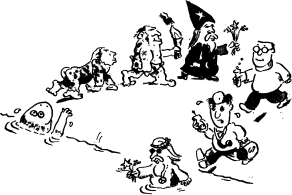
THE HISTORY OF MEDICINE IN
A NUTSHELL
2000 BC Here, eat this root.
1000 AD That root is heathen. Here, say this prayer.
1850 AD That prayer is superstition. Here, drink this potion.
1940 AD That potion is snake oil. Here, swallow this pill.
1985 AD That pill is ineffective. Here, take this antibiotic.
2000 AD That antibiotic doesnt work anymore. Here, eat this root.
Chapter 1
MEDICINE AND THE ARTS
EUNUCHS, CASTRATI AND THE LIKE
The last of the grand castrato singers, Alessendro Moreschi, died as recently as 1922. In his time he was known as The Angel of Rome and there still exists a recording of his unique voice. It was made in 1902, a year before the Pope banned that surgical whimsy which for three centuries had been performed on prepubescent boys so that they could maintain the high notes for years longer than nature intended.
Regrettably, the voice of Moreschi comes to us as being thin and tremulous, quite unlike those of former operatic maestros whose pristine quality had the audience standing at the end of an aria shouting, Long live the Knife!.
Together, Italians and the Roman Catholic Church have loved music from earliest times. Centuries ago in Venice, foundlings were left at a church door. They were accommodated (or conserved) next door at the Conservatory where they were given succour, shelter and musical training. Frustratingly, just as a boy became skilled his voice broke. So in about 1600 it was decided that to preserve the purity and marketability of a young boys voice, castration was in order.
You may recall from your childhood science classes that the longer a cord, the deeper the note it emits when plucked. The idea of castration was that if you stop the flow of the male hormone the larynx remains undeveloped, so the vocal cords do not lengthen in the normal way and the notes emitted would maintain their clear, high pitch for ever.
Many died during the crude procedure, and of those who survived, only about 1 per cent finished up with the spectacular, pristine voice necessary to become an international star. As these men were highly paid, downtrodden families saw it as a way to escape their penury, so many packed off their sons to be fixed up. The big centre for doing the operation was Norcia, well away from Rome. The surgeons were highly paid and well respected. Besides stunting the larynx, the procedure allowed the chest to become more powerful, the limbs longer and there to be a female distribution of body fat. Indeed, in opera they commonly took female parts. Paradoxically, if performing as a male, they displayed a higher pitched and stronger voice than the women they were supposed to be seducing.
Until the late eighteenth century the only opera of consequence was Italian, and it was there the idolised castrati sang their elaborate arias. Some of the musical greats wrote for them, including Mozart and Handel. Hogarth represented them in his series of paintings called The Rakes Progress.
If they did not succeed on the stage, they went into the choir to swell the volume of the songs of praise for years. As late as the end of the nineteenth century, the Vatican had 16 castrati still in its choir.
Perhaps the greatest of them all was Carlo Broschi, better known as Farinelli (17051782). He appeared before rapturous audiences throughout Europe until he was headhunted by the Spanish. There he sang to an audience of one, Philip V. The King was a chronic depressive and only comforted, it seems, by the Italians dulcet tones. The singers room was next to the monarchs, and incredibly, he sang to him every night for nine years. More incredibly still, he always sang one of only four arias.
As it turned out, many of the castrati were neither impotent nor sterile. In 1667 a chorister married. This outraged the Church which made him swear to maintain only a platonic relationship. In 1685 he wrote a book, fittingly called The Capon Marriage, and he is said to have died of a broken heart.
Another famous castrato singer by the name of Tenducci fathered two children, maintaining that originally he had three testicles and one escaped at the time of the operation!
But tastes change, and the rise of the comic opera, especially those of Rossini, saw the beginning of the end for these men.
Castration was practised in the Orient and Turkey for centuries where either the whole genitalia (true castrati), or just testes (spadones) were removed or crushed (thlibiae). From 1100 BC in China it was used not only to attain musical perfection, but also as a punitive measure. In its heyday the Emperor had 3000 eunuchs serving as slaves in his palace. The practice continued into the early part of the twentieth century. In fact, the last Chinese eunuch from the days of the Forbidden City died as recently as 1997.
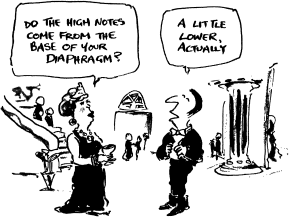
In the Turkish Empire most of the boys were operated on at a Coptic Monastery in upper Egypt. If successful, they became guardians in the Harem where equivocal surgical results made them popular with their charges. However, the death rate from the procedure was high, healing tedious, and contractures common.
Intellect, however, was never impaired, as seen in the famous story of Abelard (10791142). Despite having his genitals struck off after seducing Heloise, niece of a canon of Notre-Dame, he went on to become one of the greatest scholars of his time. This century, Sir Edward Marsh, rendered eunuchoid by severe mumps as a child, was Winston Churchills secretary for 23 years.
Several pagan religions have had their goddesses attended by eunuch priests. The best known was a Roman sect associated with Cybele. In a fit of pique her lover, Attis, had castrated himself, so after that the wandering mendicants who worshipped her were castrated to ensure purity. Her Spring festival incited such throbbing fervour that young men are said to have castrated themselves on the spot with a thoughtfully provided sword. They then ran through the streets brandishing aloft their bloody handiwork. A clamp found below London Bridge in 1840 is thought to have been used in Cybele rites. It was the epoch-making Council of Nicaea in 325 AD that stopped castration in the priesthood.
Next page

